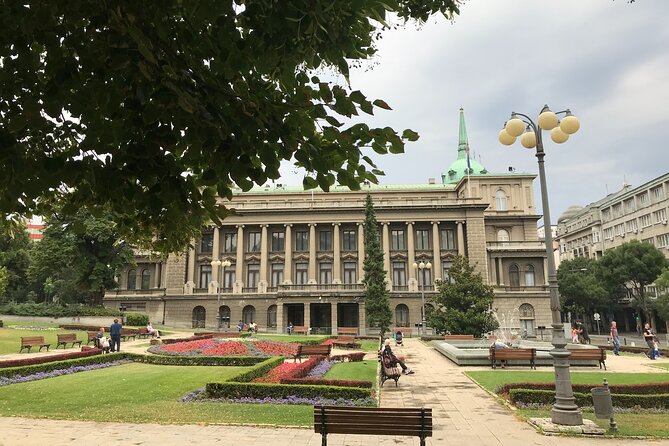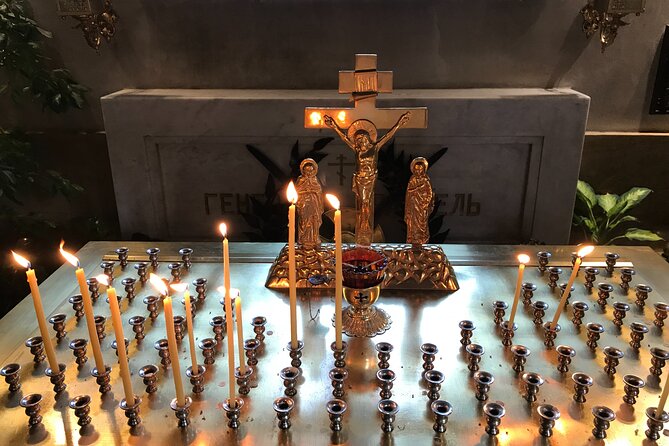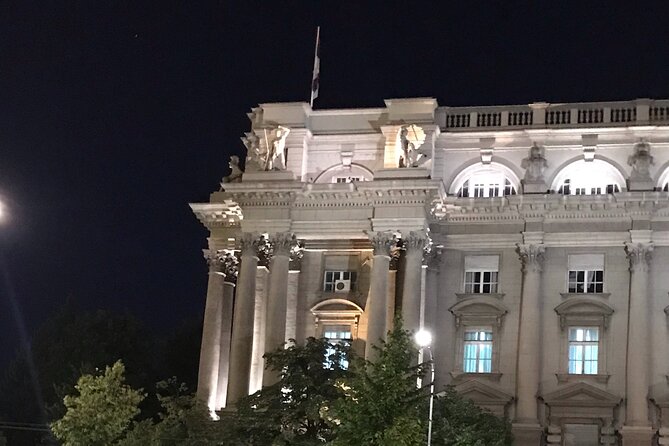After the Bolshevik seizure of power, Belgrade became a haven for White Russian émigrés fleeing the Kremlin’s persecution. These displaced aristocrats and professionals soon transformed the city into a thriving cultural hub, establishing a vibrant community known as "Little Russia." While adapting to their new Serbian surroundings, the White Russians tenaciously preserved their heritage, enriching the local landscape with their artistic and intellectual contributions. Yet, the lasting legacy of this remarkable émigré community goes beyond their cultural impact – it also reveals the profound human consequences of one of history’s most tumultuous revolutions.
Key Points

- The Bolshevik Revolution of 1917 prompted a mass exodus of anti-communist Russians, known as the "White Emigration," who sought refuge in Belgrade, Serbia.
- Russian émigrés transformed Belgrade into a cultural hub, establishing enclaves, contributing expertise, and enriching the city’s cultural landscape.
- Refugees in Belgrade formed businesses, published newspapers, and created cultural organizations to maintain Russian traditions and prevent the loss of their identity.
- Integration into Serbian society involved addressing language barriers, finding employment, and participating in local events to promote social integration.
- The White Emigration left a lasting impact on Serbian society and culture, contributing to education, science, the arts, and the preservation of Russian architectural and cultural traditions.
Escaping the Bolshevik Revolution
After the Bolshevik Revolution of 1917, many Russians fled their homeland to escape the chaos and persecution that followed. They became known as the "White Emigration," a movement of anti-communist Russians seeking refuge across Europe.
Thousands sought shelter in Serbia, which welcomed them with open arms. Belgrade, the nation’s capital, became a hub for this wave of Russian émigrés. They brought with them a rich cultural heritage, helping to shape Serbia’s artistic and intellectual landscape.
This exodus marked a significant chapter in the tumultuous history of early 20th-century Russia, as the White Emigration sought to preserve their identity and traditions in the face of the Bolshevik regime.
You can also read our reviews of more tours and experiences in Belgrade.
Arrival of White Russian Refugees

The White Russians fleeing the Bolshevik Revolution sought refuge in Serbia, where they found a welcoming home. Many settled in Belgrade, transforming the city into a hub of Russian culture and intellectual life. A wave of Russian aristocrats, professionals, and artists arrived, bringing their unique talents and traditions.
| Arrivals | Numbers | Impact |
|---|---|---|
| Aristocrats | Thousands | Established Russian enclaves |
| Professionals | Tens of Thousands | Infused Serbian society with expertise |
| Artists | Hundreds | Enriched Belgrade’s cultural landscape |
This influx of White Russians revitalized Belgrade, as the city embraced its newfound Russian character and provided a safe haven for those escaping the turmoil back home.
Establishing a Home in Belgrade

Thousands of White Russian refugees soon set about establishing their new lives in Belgrade. They opened businesses, published newspapers, and formed cultural organizations to maintain their traditions.
Many found work as professionals, using their skills and education. Despite the challenges of adapting to a different culture, the refugees built thriving communities, creating a "Little Russia" within the Serbian capital.
Though displaced from their homeland, they preserved their identity and supported one another, forging a resilient diaspora. Over time, the White Russians became an integral part of Belgrade’s diverse social fabric, leaving a lasting imprint on the city.
Preserving Cultural Identities
Many of the White Russian refugees in Belgrade dedicated themselves to preserving their rich cultural heritage. They organized cultural events, established schools, and founded institutions to maintain their language, arts, and traditions.
The White Russians were determined not to lose their identity in the foreign land. Through these efforts, they created vibrant communities that kept the spirit of old Russia alive.
Despite the hardships of exile, the refugees found solace in upholding their cultural legacy. This shared endeavor fostered a sense of unity and purpose, allowing the White Russians to retain their distinctive identity within the Serbian capital.
Adapting to Serbian Society
Refugees from the White Russian diaspora in Belgrade gradually integrated into Serbian society, navigating the challenges of resettlement. Many found work as professionals, academics, and entrepreneurs, contributing to the city’s cultural and economic fabric. Adapting to the local language and customs was crucial, and the Russian community formed organizations to preserve their heritage. The integration process was not without difficulties, but the shared Slavic roots and Orthodox faith helped ease the transition. As seen in the table below, the refugees eventually became active members of Serbian society, blending their unique identities with the local way of life.
| Adaptation Challenges | Strategies for Integration |
|---|---|
| Language barriers | Language classes |
| Cultural differences | Community organizations |
| Employment prospects | Leveraging professional skills |
| Housing availability | Assistance from Serbian hosts |
| Social integration | Participating in local events |
Charitable Efforts and Contributions
The Russian refugees in Belgrade were eager to contribute to their newfound home, leveraging their skills and experience to make a positive impact on the local community.
Many established charitable organizations to assist fellow Russians in need, providing food, clothing, and shelter.
Others volunteered at local hospitals, putting their medical expertise to use.
Skilled artisans opened workshops, training Serbian apprentices in traditional Russian crafts.
Professors and educators founded private schools, offering instruction in Russian language and culture.
Through these diverse initiatives, the White Emigres demonstrated their resilience and adaptability, while strengthening the bonds between the Russian and Serbian populations in Belgrade.
Legacy of the White Emigration
The enduring legacy of the White Emigration in Serbia can’t be overstated. This Russian diaspora left an indelible mark on Serbian society and culture.
Many émigrés became prominent figures, contributing to fields like education, science, and the arts. Their influence is evident in Belgrade’s architecture, which bears the stamp of Russian neoclassical styles.
The community’s religious and cultural traditions also persisted, with Orthodox churches and cultural societies preserving a sense of Russian identity.
While the White Emigration eventually faded, its legacy lives on, reminding Serbians of the rich tapestry of their nation’s history and the enduring connections forged in turbulent times.
Frequently Asked Questions

Is This Tour Wheelchair Accessible?
Unfortunately, this tour is not wheelchair accessible. However, it is stroller accessible for convenience. The tour is a private experience with only group participation, so it’s suitable for most travelers.
What Is the Duration and Start Time of the Tour?
The tour duration and start time are specified in the booking confirmation. Customers will receive detailed itinerary information once they’ve booked the tour. It’s best to check the confirmation for the specific timing details.
What Is the Cancellation Policy for the Tour?
The cancellation policy offers a full refund for cancellations made up to 24 hours in advance. However, no refunds are available for late cancellations. This policy applies to all bookings, and changes may incur additional fees.
How Can I Get Assistance With Questions About the Tour?
If you have any questions about the tour, you can visit the Viator Help Centre for assistance. They offer customer support and have FAQs available to provide the information you need.
What Is the Overall Rating and Review Breakdown for This Tour?
The overall rating for the tour is 5.0 out of 5 stars, based on 3 reviews. The review breakdown shows 5, 4, and 3-star ratings, indicating a positive customer experience.
Sum Up
The White Russian émigré community that found refuge in Belgrade after the Russian Revolution left an indelible mark on Serbia’s cultural landscape. They enriched the city with their artistic and intellectual talents, while also preserving their vibrant cultural identity. Though adapting to their new home, the legacy of this "Little Russia" continues to resonate in Serbia’s heritage, a testament to the enduring impact of the White Emigration.
More Tour Reviews in Belgrade
Not for you? Here's more nearby things to do in Belgrade we have reviewed
- The World of Pubs and Taverns: A Golden Mile
- From Belgrade: Novi Sad, Petrovaradin Fortress secret tunnel
- Private Novi Sad, Sremski Karlovci & Farmer’s House
- Honeymoon photography session in Belgrade
- From Belgrade: Tara National Park & Drina River Valley Tour
- E Scooter Communist tour New Belgrade
- Zasavica Safari Tour
- E Scooter Craft Beer and Breweries tour
- Western Serbia 1-Day Tour of the Key Sites from Belgrade
- Downtown Belgrade Walking Tour with Smartphone App
- From Belgrade: Mokra Gora Sargan 8 train,Mecavnik & Zlatibor
- From Belgrade: Sargan 8 Railway and Wooden City 1 Day Tour
